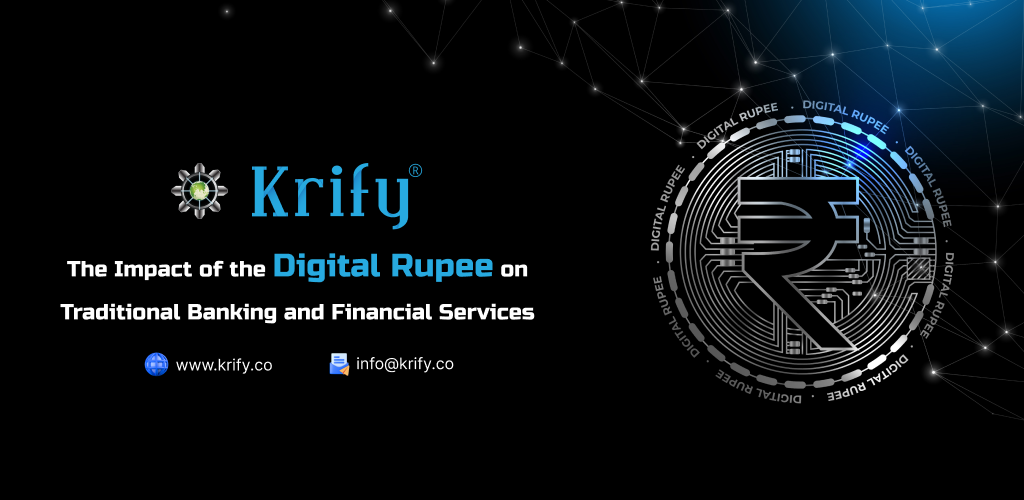The digital rupee, or e-rupee, represents a groundbreaking shift in India’s financial ecosystem. As a central bank digital currency (CBDC), it holds the promise of transforming conventional banking and financial services. This blog will delve into the potential effects of the digital rupee, examining its benefits, challenges, and its implications for the future of finance.
Brief Overview: The Evolution of Money From barter systems to the era of digital currencies, money has evolved significantly. The introduction of the digital rupee marks the latest step in this evolution.
The Rise of the Digital Rupee: An introduction to the digital rupee, its purpose, and its implementation in India, highlighting its potential to transform traditional banking and financial services.
What is the Digital Rupee?
Definition and Concept: The digital rupee is a central bank digital currency (CBDC) issued by the Reserve Bank of India (RBI). Unlike cryptocurrencies, which are decentralized, the digital rupee is a government-backed, digital form of the Indian rupee, serving as legal tender for transactions.
The Role of RBI: The Reserve Bank of India is spearheading the digital rupee initiative, with a focus on enhancing the efficiency and security of financial transactions.
Comparison with Traditional Currency: Unlike physical currency, the digital rupee is issued, controlled, and used digitally, offering advantages like reduced costs, increased transparency, and enhanced security.
Understanding the Digital Rupee
The digital rupee represents the Indian rupee in a digital format, issued by the Reserve Bank of India (RBI). It is a legal tender, designed to function just like physical money but with several added benefits:
- Increased Financial Inclusion: By making financial services more accessible, the digital rupee can help reduce poverty and boost economic growth.
- Reduced Transaction Costs: By eliminating intermediaries, such as banks, it lowers transaction costs and enhances payment efficiency.
- Improved Security: The digital rupee can mitigate risks related to counterfeit currency and fraud.
- Enhanced Cross-Border Payments: It allows for faster and more efficient international transactions, lowering costs and fostering trade.
Impact on Traditional Banking Services
- Banking Transactions: The digital rupee has the potential to streamline and secure banking transactions.
- Payment Systems: It could transform payment methods, enabling instant and seamless transactions.
- Cost Reduction: Banks may experience reduced operational costs, particularly in areas like cash handling, distribution, and security.
- Customer Experience: Faster, more efficient services could significantly improve customer experience.
Potential Impact on Traditional Banking
The adoption of the digital rupee could lead to several changes in traditional banking, including:
- Increased Competition: Traditional banks might face greater competition from non-bank financial institutions and fintech startups offering digital payment services.
- Reduced Demand for Physical Cash: As digital currency use grows, the demand for cash may decrease, prompting changes in banking operations.
- New Revenue Opportunities: Banks can capitalize on new revenue streams by developing digital payment services and financial products tied to the digital rupee.
Impact on Financial Services
- Financial Inclusion: The digital rupee could bring unbanked populations into the formal financial system.
- Credit and Lending: It could streamline credit distribution with faster processing and better tracking.
- Investment and Wealth Management: The digital rupee could simplify investment processes.
- Regulatory and Compliance Changes: Financial institutions may need to adjust to new regulations introduced with the digital rupee.
Challenges and Concerns
Despite its potential, the digital rupee poses several challenges:
- Security and Privacy: Digital currencies can bring data security and privacy risks.
- Technology Adoption: Financial institutions might face hurdles in integrating new technologies.
- Economic Stability: The digital rupee could impact the broader economy and traditional monetary policies.
- Regulatory Framework: Effective regulations are necessary to govern its use and protect consumers.
Opportunities for Innovation
- Fintech Integration: Fintech companies could leverage the digital rupee to develop innovative financial products.
- Smart Contracts and Blockchain: The digital rupee could facilitate transactions and smart contracts on blockchain platforms.
- Global Perspective: By learning from how other countries implement digital currencies, India could refine its approach.
Conclusion
The digital rupee has the potential to reshape India’s financial landscape by enhancing financial inclusion, reducing transaction costs, and improving security. Although challenges exist, the benefits of this digital currency make it a promising development. As the e-rupee gains traction, it is likely to leave a profound impact on traditional banking and financial services. Contact Us



